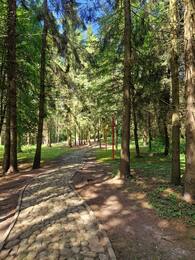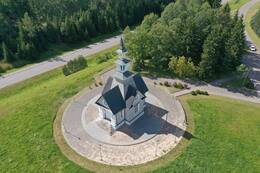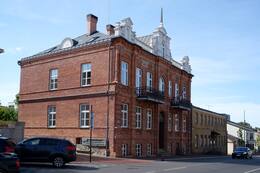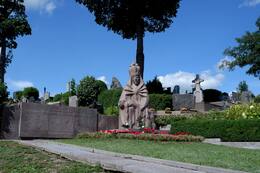Rainių žudynės: netikėtai atrastos aukos
On June 24-25, 1941, in the Rainiai forest, near Telšiai, the NKVD and Red Army soldiers brutally tortured 73 political prisoners from Telšiai prison - this became one of the most horrific Soviet crimes in Lithuania.
JUNE 26. The war shots had already stopped in the Telšiai area. I went to see what was happening at the Telšiai city fire brigade. I found a car in the city. The head of the tractor station was sitting in it. He began to explain that the car was missing a spark plug, which could be obtained at the tractor station. I got in his car and drove to the Rainiai manor tractor station.
“On the left side of the Rainiai forest, there was a car trailer left by the Russians, and nearby the villagers were loading military material into their carts. I reported this to the Telšiai police chief. He gave me a pistol and told me to take care of it myself. On June 28, it was necessary to replace the guards of the Rainiai forest, who had been stationed near the car trailer. However, when I went, there was no one to replace these guards and I decided to leave the same ones until I got horses to transport the trailer. In the forest, I saw two men who were pumping gasoline from a car. After checking their passports, it turned out that they were brothers from a nearby area.
“Nearby we saw a wheelbarrow of machinery, several buckets of cabbage and Russian papers. We also saw mounds of earth, which were partially covered with moss, but the signs of digging were clearly visible. We guessed that weapons or larger parts of machinery might have been buried there. The guard was ordered to dig one hole and, after digging 30 cm, he began to feel that there was soft clothing there. I handed him a knife. After washing the clothes, a man's blue chest appeared. We decided that it couldn't be a soldier, because when soldiers are buried, no one takes off their clothes, and here blue underwear was visible. I ordered them to pull it out. When they pulled it out, we saw a terrible sight. There were countless legs, heads, and arms in the hole. . . .
"Leaving the guard, I went to report to the Telšiai police that many bodies had been found in the pit, which might not be prisoners of the Telšiai prison. The police chief ordered the bodies to be dug up."
"When I returned to the forest, I found three corpses on the shore, and others were visible in the pit. There were also corpses 15-20 cm below the other pits. It was then clear that these were men who had been in prison.
“After receiving support from the Rainiai Manor, we began work. Terribly mutilated corpses lay in the pits. They were dug up and laid in rows on the ground. Their heads were smashed, their hands tied behind their backs, their bodies stabbed and covered in black spots. It must be assumed that the cabbages found were used to swell their arms and legs. The cruelty was the greatest. It was in 1941, on June 28, at 2 p.m. By evening, all the pits, in which 73 corpses were found, had been dug up.”
Related timeline
Related topics
Related objects
Memorials in Rainiai Forest - the place of the martyrs' murder
The Rainiai Passion Chapel is located in the village of Rainiai, 5 km from Telšiai, next to road 160 Telšiai-Varniai - Laukuva.
On June 25-26, 1941, one of the most horrific massacres in the history of the Soviet occupation of Lithuania took place in the Rainiai forest. At night, 75 political prisoners from Telšiai prison were brutally tortured by the Red Army and the repressive institutions of the USSR. The victims, buried in a common grave, were found a few days later by a random passerby.
To honor the victims of the massacre, the construction of the Chapel began in 1943, based on the idea of architect Jonas Virakas. The Soviet authorities, upon returning, demolished it in 1944. Later, in 1990, after Lithuania regained its independence, architect A. Žebrauskas, based on the drawings of the same author, began building another chapel. The chapel was consecrated on June 23, 1991, commemorating the 50th anniversary of the Rainiai Massacre.
The Rainiai Suffering Chapel is not only dedicated to the memory of the Rainiai martyrs, but also perpetuates the memory of all victims of Soviet terror. In the forest next to the chapel, where political prisoners were tortured, a stone cross carved by sculptor R. Midvikis was erected. Three more wooden crosses, painted in the colors of the national flag, stand along the way. They were erected by local people shortly after the massacres, but the villagers drowned them in the Viešvėnai Pond. Only recently, after the pond was drained, were the crosses found, painted and restored.
Rainiai Chapel of Suffering
The Rainiai Chapel of Suffering is located in the village of Rainiai, at a distance of five kilometres from Telšiai, off road No. 160 Telšiai-Varniai-Laukuva.
On 25 and 26 June 1941, one of the most horrific massacres in the history of the Soviet occupation of Lithuania took place in Rainiai Forest. At night, the Red Army and the Soviet repressive authorities brutally tortured 75 political prisoners to death in Telšiai Prison. A few days later, a passer-by found the victims buried in a mass grave.
In 1943, a chapel was built in memory of the victims, which was built according to the sketch of the architect Jonas Virakas. In 1944, with the return of Soviet rule, the chapel was destroyed. Later, in 1990, after Lithuania regained its independence, the architect A. Žebrauskas started to build a new chapel based on the sketches by the same author. The chapel was consecrated on 23 June 1991 to commemorate the 50th anniversary of the Rainiai massacre.
The Rainiai Chapel of Suffering is dedicated not only to the martyrs of the Rainiai but also to the memory of all the victims of Soviet terror. A stone cross carved by sculptor R. Midvikas is erected in the forest near the chapel, where political prisoners were tortured. Three more wooden crosses painted in the colours of the national flag can be seen on the road.
Former Telšiai Prison
The former Telšiai Prison building stands on Respublikos Street, in the central part of Telšiai city.
After the Telšiai fire of 1908, a private individual, a wealthy Jew named Neiman, built a neo-Gothic building in the historicist style. He agreed with the occupying tsarist authorities that he would build the building for the purpose of the district police board building that had burned down in the fire, according to the conditions specified by the authorities, and rent it to the authorities. It was one of the most beautiful buildings in Telšiai. During the First World War, the building was adapted for the Telšiai district prison. It was used as a prison both during the period of independent Lithuania (1918-1940) and during the Soviet occupation, until the beginning of the 1950s. In 1940-1941, 1944-1953, the building housed the NKGB–MGB–KGB Telšiai district internal prison.
On June 22, 1941, with the outbreak of the imperialist war between the Soviet Union and Nazi Germany, 162 prisoners were imprisoned in Telšiai prison – 76 NKGB interrogated prisoners. On June 23, there was an attempt to transport all the prisoners, but this plan failed because the local leaders of the Communist Party, the NKVD and the NKGB fled the city. No vehicles were provided for the transport of the prisoners. On the morning of June 24, 1941, Telšiai prison was surrounded by a unit of the 123rd Division of the 8th Red Army, and a three-judge court was hastily formed, headed by the NKGB Telšiai County Chief Petar Raslanas – so he, the Chairman of the Telšiai Executive Committee Domas Rocius and the Deputy Chief of the NKGB Kretinga County, State Security Lieutenant Yermolajevas, and others. All 76 political prisoners in Telšiai prison were sentenced to death. The other prisoners were released home. The short night of June 25th - dawn was already timidly breaking in the east when trucks with prisoners moved towards Rainiai. Three prisoners managed to escape from the trucks - unfortunately, they were soon caught by Red Army bullets... The mutilated bodies of 73 prisoners were accidentally found in Rainiai on June 28, 1941.
Later, the Telšiai Music School was located in the building, which operated here until 1994. Unfortunately, the building was severely damaged both externally and internally during the Soviet era.
During the restoration of the building, inside the walls, inscriptions of names, Gediminas' pillars, and various dates were discovered. Walled-up grottoes were also discovered.
On June 24, 1997, a memorial plaque was unveiled near the building by the Telšiai branch of the Lithuanian Prison Service, dedicated to the memory of 73 political prisoners of Telšiai Prison who were tortured in the Rainiai forest on the night of June 24-25, 1941.
In 2006, in memory of the 65th anniversary of the martyrdom of the Rainiai Martyrs, an artistic memorial plaque was unveiled near the former prison (author - Gintaras Gailius, architect - Algirdas Žebrauskas).
Tombstone "Pieta"
The monument stands in the old cemetery of the city of Telšiai.
On the night of June 24-25, 1941, in the Rainiai forest, employees of the Telšiai County Department of the NKVD-NKGB and their assistants executed 75 political prisoners from the Telšiai prison. The victims were tortured in the most brutal ways – some had their eyes gouged out, their ears and genitals cut off, and their heads crushed. Only 10 prisoners were shot. After the massacre, not a single living witness remained, except for the executioners themselves. Near the burial site of the victims, 3 corpses of Red Army soldiers with gunshot wounds to the back of the head were found buried, their burial place is unknown. The remains of 65 victims of terror were buried in the old cemetery of the city of Telšiai. During the years of Soviet occupation, attempts to commemorate the anniversary of the Rainiai massacre, to take care of the grave or to install a tombstone with names were prevented.
Today, the cemetery is home to the monument "Pieta", unveiled on June 23, 1996, depicting the Mother of God holding the body of Christ taken down from the Cross on her knees. The authors of the monument are the artist-sculptor Antanas Kmieliauskas, sculptor Osvaldas Neniškis and architect Algirdas Žebrauskas.








